Chapter 05: Content Pipeline
Learn the advantages of using the Content Pipeline to load assets and go through the processes of loading your first asset
Every game has assets; images to represent the visual graphics to players, audio to provide sound effects and background music, fonts to render text with, and much more. These assets start out as raw files (e.g. .png image files or .mp3 audio files), which you'll need to load into the game to use.
Loading Assets
Loading assets can be done during runtime directly from file, or it can be loaded through the Content Pipeline Both of these methods are two sides of the same coin and there are trade offs to each approach.
For instance, to load an image file directly at runtime, you would need to:
- Add the image file to your project.
- Configure the project to copy the image file on build to the build output directory.
- Load the image file as a texture at runtime using the Texture2D.FromFile method.
Important
A big disadvantage to loading an image file as a texture directly, is when that when it loads it, it does so in its compressed format such as .png or .jpg. These compression formats are not understood by a Graphics Processing Unit (GPU); they will need to be decompressed into raw bytes as a format the GPU does understand before it can store the data. Doing this can potentially leave a larger memory footprint for your assets. You will also need to handle how different compression formats work on the platform you are targeting such as desktops, mobile, and consoles.
Alternatively, as we'll explore below, using the Content Pipeline handles this for you automatically.
On the other side of this coin, MonoGame offers the Content Pipeline; a workflow for managing assets. The workflow is made up of a set of tools and utilities that are automatically added by default when you create a new MonoGame project using the MonoGame project templates. To use this workflow, you need to:
- Add the asset file to your content project (Content.mgcb file) using the MonoGame Content Builder Editor (MGCB Editor).
- Perform a project build. Doing this, the MonoGame.Content.Builder.Tasks NuGet reference will compile the assets defined in the content project, optimized for the target platform, and automatically copy them to the game project build directory.
- Load the compiled asset at runtime using the ContentManager.
The following image illustrates this workflow:
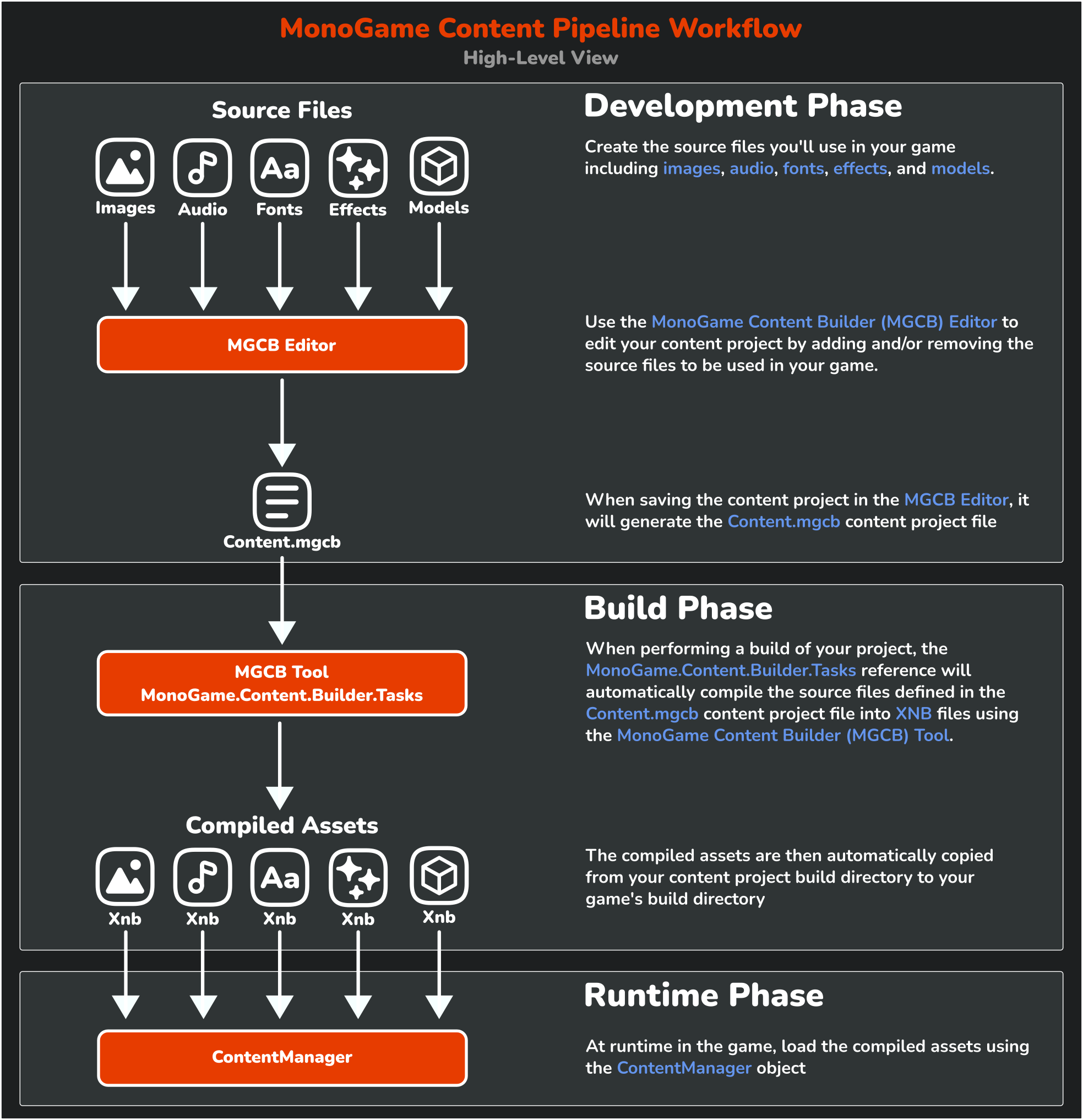 |
|---|
| Figure 5-1: MonoGame Content Pipeline Workflow |
For the same amount of steps, you also get the benefit of the assets being pre-processed and compiled to an optimized format for the target platform. For instance, image files can be compiled using DXT compression, which is a format that is understood by GPUs without needing to be decompressed first, reducing the memory footprint.
Note
For more information on the benefits of compiling assets and what optimizations it can offer, see the Content Pipeline documentation.
For this tutorial series, we are going to focus on using the content pipeline workflow to load assets. Doing this will get you as the developer accustomed to using the content pipeline tools and also give the benefits of having assets precompiled to optimized formats.
The MGCB Editor
The MGCB Editor is a GUI tool that can be used to edit your content project. This tool is automatically added to your game project as a local dotnet tool when you create a new MonoGame game project using one of the MonoGame project templates. Using the editor, you can add existing assets to the content project for your game, or create a new asset using one of the built-in types in the MGCB Editor:
- Effect (.fx): A shader file that creates custom visual effects by controlling how graphics are rendered on the GPU.
- LocalizedSpriteFont Description (.spritefont): A configuration file for creating fonts with support for multiple languages.
- Sprite Effect (.fx): A shader specifically designed for use with 2D sprites to create special visual effects.
- SpriteFont Description (.spritefont): A configuration file that defines how text will be displayed in your game, including character set and font properties.
- Xml Content (.xml): A structured data file for storing game information like levels, dialogues, or configuration settings.
Note
The content project is the Content.mgcb file in your game project directory. This file can be edited manually by hand, however it's much easier to use the MGCB Editor instead.
Opening the MGCB Editor
There are different methods of opening the MGCB Editor tool depending on your IDE and environment:
To open the Content.mgcb content project file in the MGCB Editor with Visual Studio Code, you can use the MonoGame for VSCode extension. You should have installed this extension in Chapter 02. With this extension install, anytime you have a code file open, you will see the MonoGame logo in the top-right of the code window like below:
| Figure 5-2: MonoGame for VSCode extension icon |
Clicking the MonoGame logo here will open the Content.mgcb content project file from the current project in the MGCB Editor.
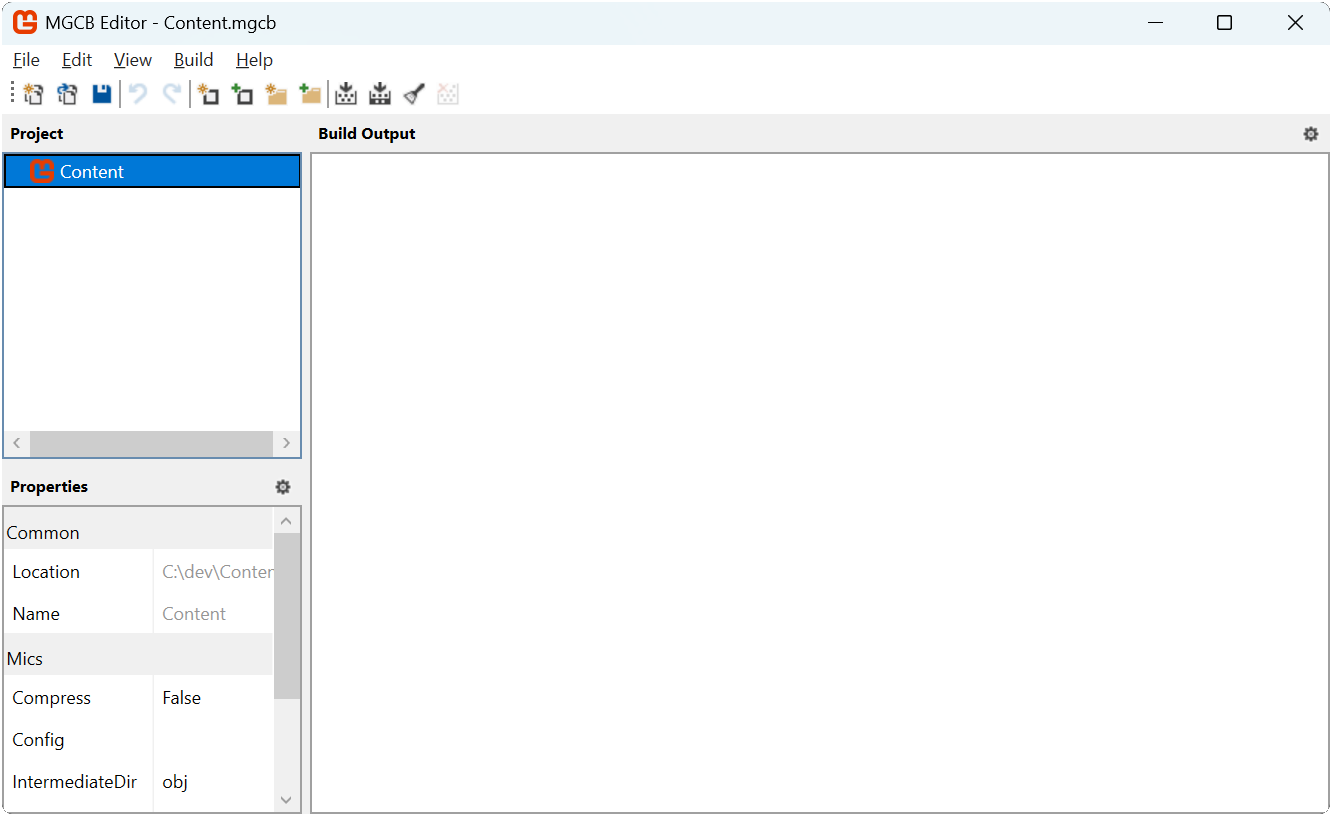 |
|---|
| Figure 5-3: MonoGame Content Builder Editor (MGCB Editor) Window |
In Figure 5-3 above, you can see the user interface for the MGCB Editor:
- Toolbar: Contains icon buttons for common actions such as creating new items, opening files, saving changes, and building content.
- Project Panel: Located on the left of the MGCB Editor, displays a hierarchial tree view of all content items added to the content project. The root node Content represents the root of the content project.
- Properties Panel: Located on the bottom left of the MGCB Editor, shows the properties of the currently selected item in the project panel. The properties available are based on the item type selected.
- Build Output Panel: The large area to the right side outputs build messages, warnings, and errors when content is processed.
Adding Existing Assets
To add an existing asset to the content project:
- In the Project panel, select the folder where you want to add the item. If you want to add it to the root, select the main Content node.
- Right-click on the selected folder and choose Add > Existing Item... from the context menu.
- In the file browser that appears, navigate to the location of the file you want to add.
- Select the file(s) you want to add and click Open.
When adding existing assets to the content project, a pop-up dialog will appear with the following options:
- Copy the file to the directory: Creates a duplicate of the file inside your project's Content directory. This creates an independent copy, meaning any later changes to the original file won't affect your project.
- Add a link: Creates a reference to the original file without making a copy. This maintains a connection to the source file, so any updates to the original will be included when you build. Note that the link uses a path relative to the Content.mgcb file, so if either the source file or your project moves, you'll need to reestablish the link.
- Skip: Cancels adding the current file while continuing with any other selected files.
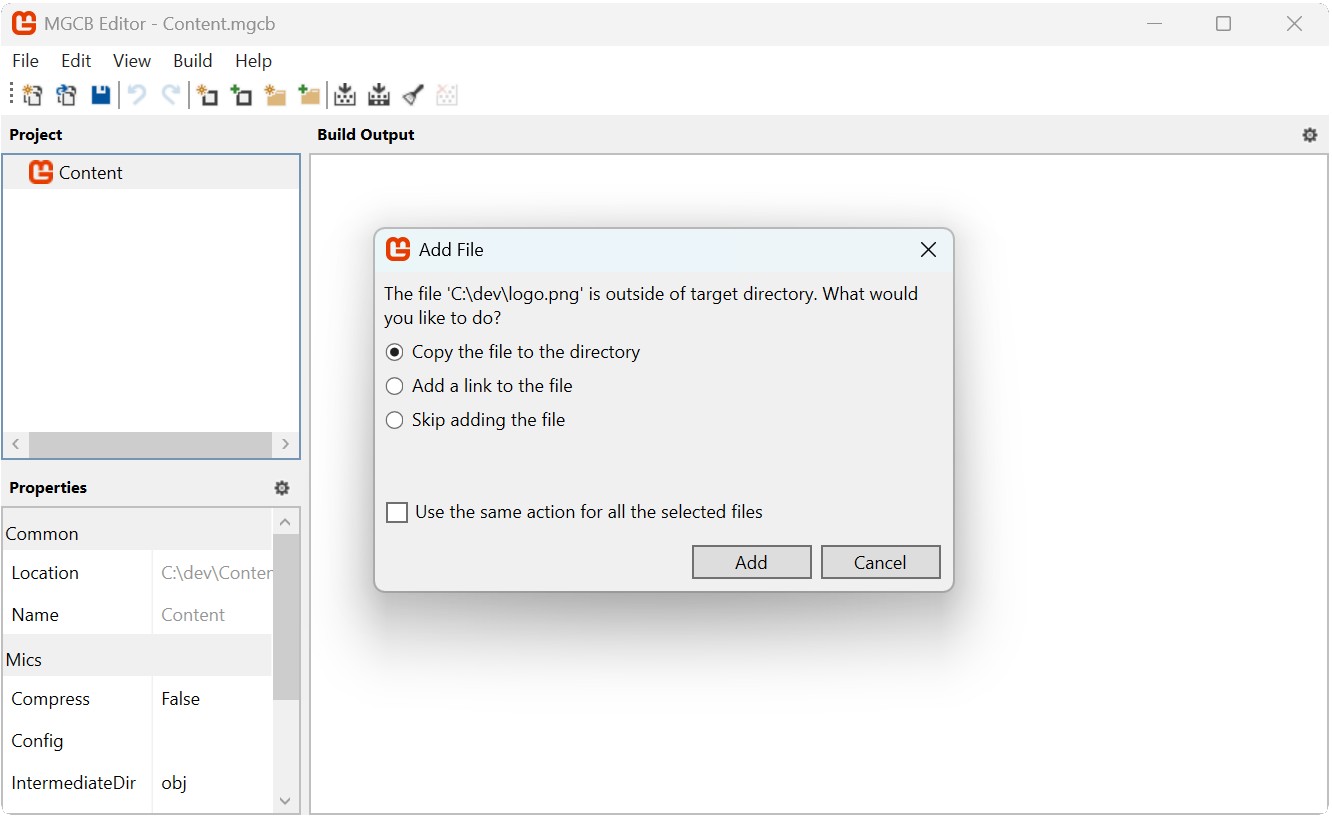 |
|---|
| Figure 5-4: Add existing file pop-up |
Adding Built-In Asset Types
To create a new asset using one of the built-in types in the MGCB Editor:
- In the Project panel, select the folder where you want to add the new asset. If you want to add it to the root, select the main Content node.
- Right-click on the selected folder and choose Add > New Item... from the context menu.
- In the dialog that appears, select the type of asset you want to create from the list of available built-in types:
- Effect (.fx): A shader file that creates custom visual effects by controlling how graphics are rendered on the GPU.
- SpriteFont Description (.spritefont): A configuration file that defines how text will be displayed in your game, including character set and font properties.
- Sprite Effect (.fx): A shader specifically designed for use with 2D sprites to create special visual effects.
- Xml Content (.xml): A structured data file for storing game information like levels, dialogues, or configuration settings.
- LocalizedSpriteFont Description (.spritefont): A configuration file for creating fonts with support for multiple languages.
- Enter a name for your new asset in the Name field.
- Click Create to add the new asset to your project.
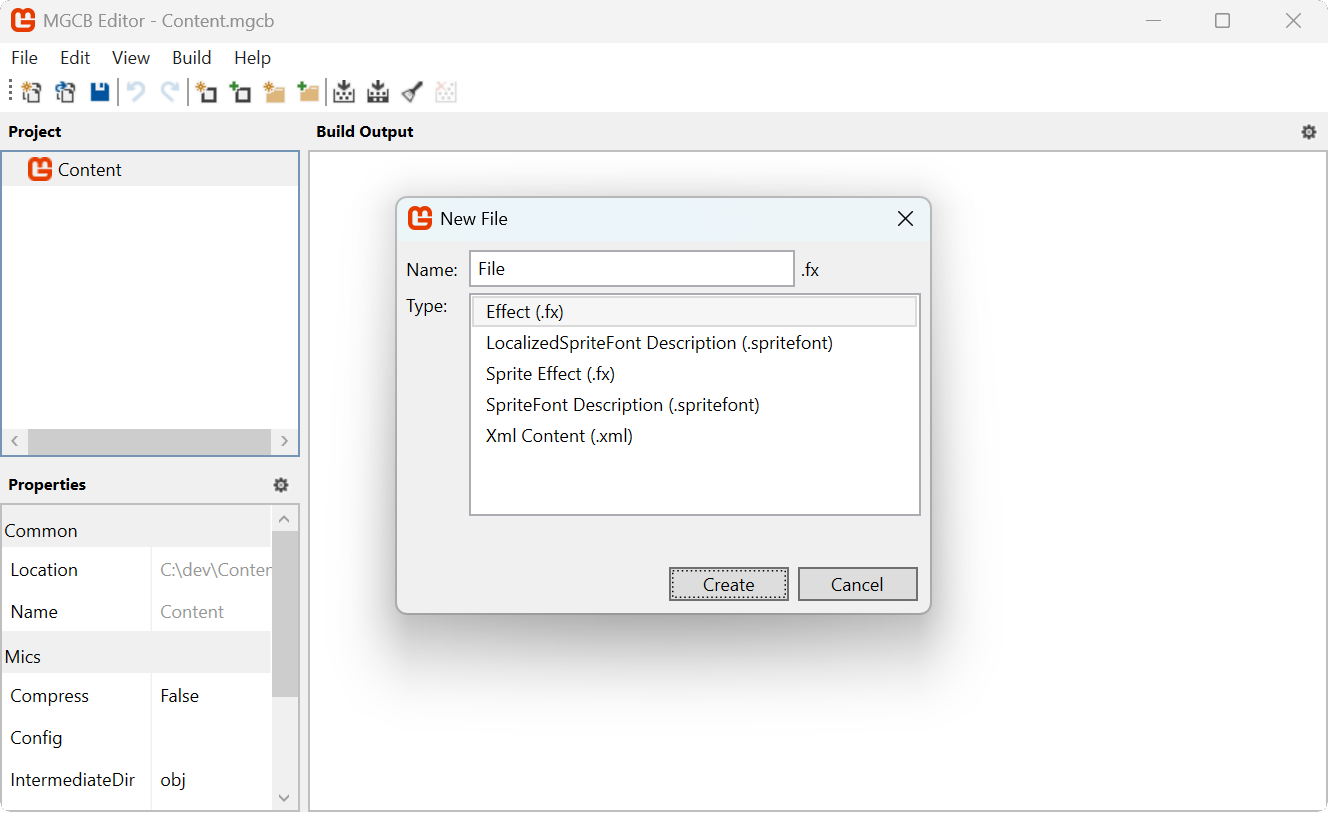 |
|---|
| Figure 5-5: New file pop-up |
Note
Each built-in asset type comes with a template that includes the minimum required structure and settings.
Adding Folders to Organize Content
Organizing your game assets into folders helps keep your content project manageable as it grows. To add a new folder:
- In the Project panel, select the location where you want to create a new folder. This can be the root Content node or another existing folder.
- Right-click on the selected location and choose Add > New Folder... from the context menu.
- Type a name for the new folder and click Ok.
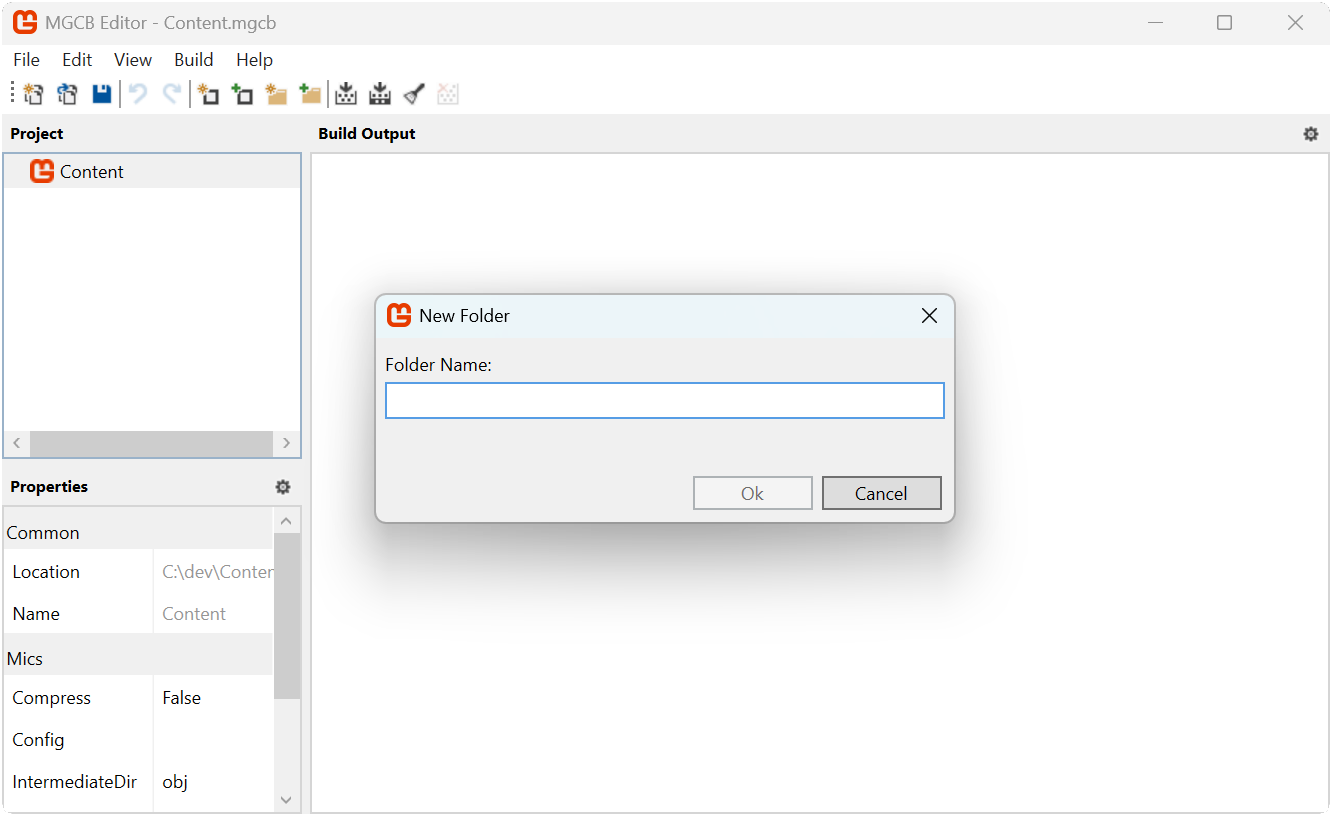 |
|---|
| **Figure 5-6: New folder pop-up |
The new folder will appear in your content tree, and you can now add items to it by:
- Adding existing assets directly to the folder
- Creating new assets within the folder
The folder structure you create in the MGCB Editor affects how you'll access your content in code. It's good practice to establish a folder structure early in your project development to avoid having to reorganize and update content paths later.
The ContentManager Class
To load assets in code that have been processed through the content pipeline, MonoGame provides the ContentManager class.
Note
The Game class provides the Content property which is ready to use instance of the ContentManager.
ContentManager Properties
The ContentManager offers the following properties:
| Property | Type | Description |
|---|---|---|
| RootDirectory | string |
The root directory the content manager searches for assets. |
| ServiceProvider | IServiceProvider |
The service provider used by the content manager. |
ContentManager Methods
The ContentManager offers the following methods:
| Method | Returns | Description |
|---|---|---|
| Load<T>(string) | T |
Loads the assets of type T that has been processed by the content pipeline. |
| LoadLocalized<T>(string) | T |
Loads the asset of type T that has been processed by the content pipeline using prepending the CultureInfo.CurrentCulture value to the end of the asset name. (e.g. "assetname.en-US") |
| Unload | void |
Unloads all assets that have been loaded by that content manager instance. |
| UnloadAsset(string) | void |
Unloads the asset with the specified name that has been loaded by that content manager instance. |
| UnloadAssets(IList<string>) | void |
Unloads the assets that have been loaded by that content manager with the names specified in the list provided. |
| Dispose | void |
Unloads all assets from the content manager and disposes of the content manager instance. |
Tip
When an asset is loaded for the first time, the ContentManager will internally cache the loaded asset. Loading that same asset later will return the cached asset instead of having to perform another disk read to load the asset again.
Tip
When an asset is unloaded, if the asset type implements the IDisposable interface, the Dispose method will automatically be called on the asset during the unload process.
When loading an asset, the load methods require two parts:
TType Reference: The content type we are loading.assetNameParameter: A string path that matches the content path of the asset to load.
Understanding Content Paths
The folder structure you create in the MGCB Editor directly affects how you load content in your game. When you perform a build of your game project, the MonoGame.Content.Builder.Tasks NuGet package reference will:
- Compile the assets into an optimized format in the content project's output directory (typically ProjectRoot/Content/bin/Platform/Content) as an .xnb file.
- Copy the compiled assets to your game's output directory (typically ProjectRoot/bin/Debug/net8.0/Content or ProjectRoot/bin/Release/net8.0/Content).
For example, if your content project contains:
Content/
├── images/
│ └── logo.png
└── sounds/
└── music.mp3
then when the tasks first compiles the assets, they will be output to:
ProjectRoot/
└── bin/
└── Debug/
└── net8.0/
└── Content/
├── images/
│ └── logo.xnb
└── sounds/
└── music.xnb
Then after compiling them and copying them to the game projects output directory, it will look like the following:
ProjectRoot/
└── Content/
└── bin/
└── DesktopGL/
└── Content/
├── images/
│ └── logo.xnb
└── sounds/
└── music.xnb
When the ContentManager is used to load these assets, it looks for them relative to its RootDirectory property. By default, this is set to "Content" in the Game1 constructor to match where the compiled assets are copied. The path used to load an asset must match its location relative to the RootDirectory, minus any extension. For example, to load the above assets, the paths would be "images/logo" and "sounds/music".
Loading Our First Asset
Let's walk through the process of editing our content project using the MGCB Editor to add a new image asset and then load it in our game. To get started, we'll first need an image to load. Right-click the following image of the MonoGame logo and save it named logo.png somewhere on your computer:
 |
|---|
| Figure 5-7: MonoGame Horizontal Logo |
Now that we have an image file to add, perform the following:
- Open the content project in the MGCB Editor.
- Select the Content node in the Project Panel.
- Right-click on the selected Content node and choose Add > New Folder... from the context menu.
- Name the folder images and click the Ok button.
- Select the new images node in the Project Panel.
- Right-click on the selected images node and choose Add > Existing Item.. from the context menu.
- In the file browser that appears, navigate to the location of the logo.png file you just downloaded.
- Select the logo.png file click Open.
- When prompted choose the Copy the file to the directory option from the add exiting file pop-up.
- Save the changes made to the content project by selecting File > Save from the top menu.
Important
After changes have been made in the MGCB Editor, ensure that you save the changes. They are not automatically saved, though you will be warned if you close the editor and haven't saved changes. You can tell that changes have not been saved by looking at the title bar of the MGCB editor window. If it has an '*' at the end of the window title, this means changes have not been saved
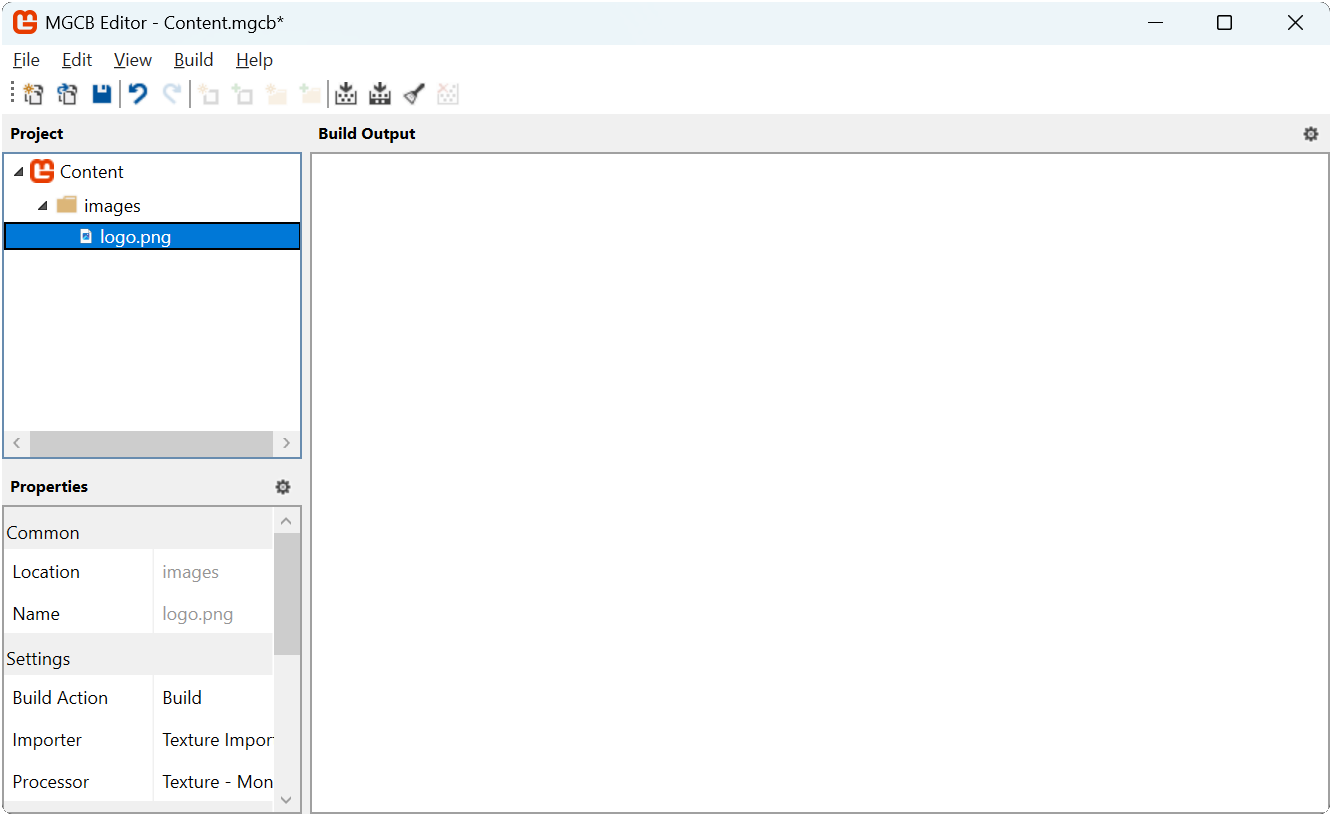 |
|---|
| Figure 5-8: The logo image added to the content project in the MGCB Editor |
With the MonoGame logo image now added to the content project, we can load it in our game and draw it. Open the Game1.cs file and make the following changes:
using Microsoft.Xna.Framework;
using Microsoft.Xna.Framework.Graphics;
using Microsoft.Xna.Framework.Input;
using MonoGameLibrary;
namespace DungeonSlime;
public class Game1 : Core
{
// The MonoGame logo texture
private Texture2D _logo;
public Game1() : base("Dungeon Slime", 1280, 720, false)
{
}
protected override void Initialize()
{
// TODO: Add your initialization logic here
base.Initialize();
}
protected override void LoadContent()
{
_logo = Content.Load<Texture2D>("images/logo");
base.LoadContent();
}
protected override void Update(GameTime gameTime)
{
if (GamePad.GetState(PlayerIndex.One).Buttons.Back == ButtonState.Pressed || Keyboard.GetState().IsKeyDown(Keys.Escape))
Exit();
// TODO: Add your update logic here
base.Update(gameTime);
}
protected override void Draw(GameTime gameTime)
{
GraphicsDevice.Clear(Color.CornflowerBlue);
// Begin the sprite batch to prepare for rendering.
SpriteBatch.Begin();
// Draw the logo texture
SpriteBatch.Draw(_logo, Vector2.Zero, Color.White);
// Always end the sprite batch when finished.
SpriteBatch.End();
base.Draw(gameTime);
}
}
The key changes made here are:
The private field
_logowas added to store the logo Texture2D once it is loaded.In LoadContent, the logo texture is loaded using the ContentManager.
In Draw the logo is drawn using the SpriteBatch.
Note
We'll go more into detail about the SpriteBatch in the next chapter.
Running the game now will show the MonoGame logo displayed in the upper-left corner of the game window.
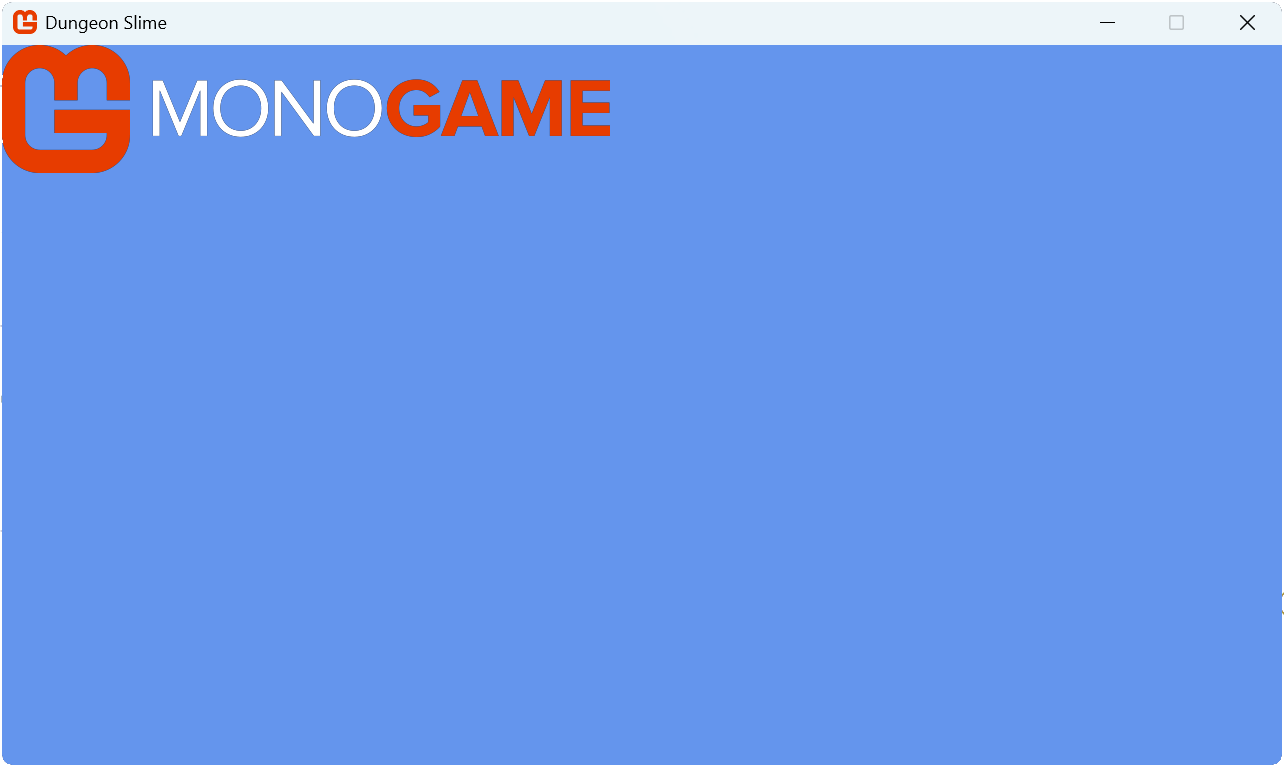 |
|---|
| Figure 5-9: The MonoGame logo drawn to the game window |
Conclusion
Let's review what you accomplished in this chapter:
- You learned about the advantages of loading assets using the Content Pipeline.
- You added an image file asset to the Content.mgcb content project using the MGCB Editor.
- You learned about the Content Pipeline workflow and how MonoGame automates the process for you.
- You loaded the image file asset using the ContentManager
In the next chapter, we'll go more into detail on working with textures and the various options available when rendering them.
Test Your Knowledge
What are the two main ways of loading a texture, and what are the pros and cons of each approach?
The two main ways to load a texture in MonoGame are:
Directly from file using Texture2D.FromFile. This method requires manually setting up file copying, offers no pre-processing benefits, and can have a higher memory footprint.
Using the content pipeline with Content.Load
. Using the content pipeline optimizes textures into formats for the target platform(s), automatically handles compiling and copying assets during build, and reduces memory footprint, but requires additional setup using the MGCB Editor.
During the MonoGame content pipeline workflow, assets are compiled and then copied to the project output directory. What is responsible for performing this task?
The MonoGame.Content.Builder.Tasks NuGet reference.